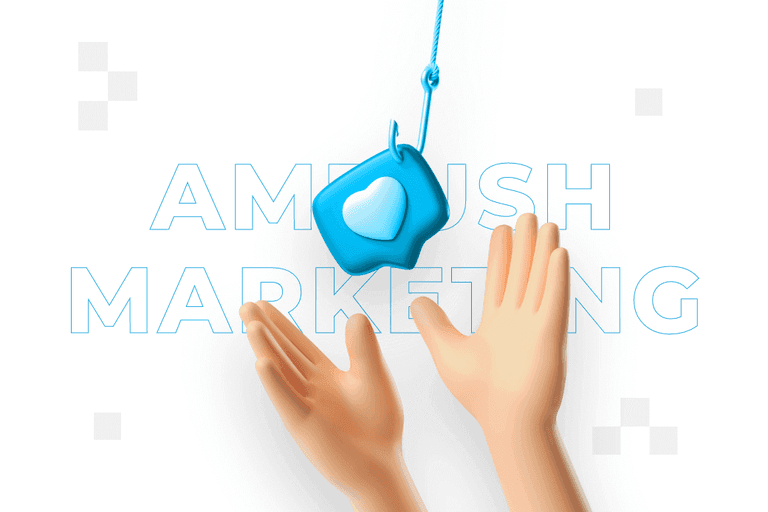
Ambush marketing – what is it?

Ambush marketing is the skilful art of exploiting popular events without the cost of official sponsorship. Although effective, this strategy often provokes controversy in the advertising world.
From this article you will learn:
- What is ambush marketing?
- What are the similarities between ambush marketing and ambient marketing?
- What are the relationships between ambush marketing and guerilla marketing?
- Where is ambush marketing most commonly used?
- What are the challenges of ambush marketing?
- What can be gained from ambush marketing?
- What are examples of successful ambush marketing?
Ambush marketing – definition
Ambush marketing, also known as ambush marketing or sneak marketing, is a strategy in which a company promotes itself and its products in the context of an event without being an official sponsor of that event. The aim is to create the impression that the company has an official connection to the event or simply to benefit from the attention attached to the event without paying for sponsorship rights.
Ambush marketing is a promotional strategy in which a company benefits from the exposure of a major event without being an official sponsor.
Definition of ambush marketing
More broadly, ambush marketing is understood as a strategy to draw the attention of an audience that is currently interacting with brand X towards brand Y. This is a controversial approach as it can be seen as exploiting someone’s event or brand without making a financial contribution. Event organisers often take legal action to protect their official sponsors from this type of practice.
Ambush marketing versus ambient marketing
Ambient marketing is a form of advertising that uses unconventional places and elements of the environment to convey an advertising message. It can be, for example, advertising placed on underground steps, on bus seats or in other places where advertising is not expected. The main aim is to surprise the recipient and stand out in a crowded advertising world.
The similarity between ambush marketing and ambient marketing stems from the desire to surprise the recipient and the attempt to stand out in the clutter of other marketing messages. The difference lies mainly in the context – ambush marketing is associated with large events and an attempt to ‘plug in’ to their popularity without official patronage, whereas ambient marketing focuses on using the environment as an advertising medium. Both strategies can be used together in certain situations. For example, a company may use the ambush marketing technique during a major sporting event by placing unconventional advertisements (ambient marketing) in locations near the event.
Ambush marketing versus guerilla marketing
Guerilla marketing is a form of marketing that involves unconventional, often surprising promotional activities carried out with a limited budget. It is a strategy that relies on creativity, surprise and direct contact with consumers in places where they are not expected. The main similarity between ambush and guerilla marketing is the desire to surprise the audience and use the effect of surprise to attract attention in a crowded advertising world. The difference is that ambush marketing is more focused on ‘crediting’ other events, whereas guerilla marketing focuses on creating surprising promotional activities.
Application of ambush marketing
Ambush marketing is a relatively controversial marketing strategy, but it is nevertheless sometimes effective and is used by various brands around the world. Here are a few ways:
- Major sporting events – this is one of the most popular venues for ambush marketing strategies. A company that is not an official sponsor of a sporting event can try to associate with it unofficially. For example, during the FIFA World Cup or the Olympic Games, brands that are not official sponsors may run advertising campaigns suggesting some association with the event.
- Concerts and festivals – companies may give away product samples, organise competitions or run other promotional activities around the venue in an effort to benefit from the attention directed at the main event.
- Conferences and trade shows – brands may try to capture the attention of attendees by holding their own informal events at the same place or time as the main event.
- Advertisements and media campaigns – some brands create advertisements that implicitly refer to the main event, not using official names or logos, but suggesting some connection.
- Social media campaigns – brands often use popular hashtags associated with major events to promote their products or services, even if they are not officially associated with the event.
- Sponsorship of athletes – a company may not be able to sponsor a major sporting event due to cost, but may sponsor individual athletes who take part.
Challenges of ambush marketing
Ambush marketing is a controversial but sometimes effective marketing strategy, but one that comes with several challenges – one of the main ones being legal issues. Event organisers and their official sponsors are protected by law and can take action against companies that use ambush marketing. They often invest large sums in promotion and their actions can overshadow the attempts of companies using this form of marketing. Successful implementation of such a strategy requires precise planning and a creative approach, which is not always easy to achieve, especially when a brand tries to act discreetly.
The risks associated with public relations are also not insignificant. If the campaign is not well received by the audience, this can lead to negative media coverage and damage the brand’s reputation. Additionally, if audiences feel that the brand is trying to mislead them, this can negatively affect the brand’s image.
Ambush marketing tends to be short-lived, making it difficult to convert short-term audience attention into long-term engagement. The effectiveness of this strategy is also more difficult to predict than more traditional methods.
Benefits of ambush marketing
Ambush marketing, despite its controversial nature, is often used because of the many benefits it offers. One of the biggest advantages is its ability to grab attention in a short period of time. Companies can take advantage of a ready and engaged audience that is already focused around a specific event or topic. Brands can also tap into the positive emotions and passions associated with major events. By associating its product or service with such an event, a company can hope that positive feelings will be transferred to its brand.
Ambush marketing also provides a great opportunity to demonstrate creativity and innovation. Unusual and surprising campaigns are often widely shared on social media, further increasing their reach. This can have comparative benefits in terms of brand recognition and audience engagement, especially in the context of increasingly expensive traditional marketing.
Examples of ambush marketing
Ambush marketing has occurred many times in the history of marketing. Here are some well-known examples:
- Nike at the Barcelona Olympics (1992) – Reebok was the official sponsor of the Games, but it was Nike that gained a lot of attention by purchasing billboards around Barcelona and sponsoring athletes who wore their clothing and shoes during the medal ceremonies[1].
- Beats by Dre at the London Olympics (2012) – although Panasonic was the official sponsor in the audio category, many sports stars wore headphones sent by Beats by Dre, giving the brand huge exposure[2].
- Bavaria Brewery at the 2010 FIFA World Cup – a group of Dutch female fans were ejected from a match for wearing orange miniskirts promoting the Dutch brewery Bavaria. FIFA considered this an ambush marketing action, as rival brewery Budweiser was an official sponsor of the tournament[3].
- American Express at the Los Angeles Summer Olympics (1984) – Visa was an official sponsor of the games, but American Express released an advert that read “You don’t need Visa to get into the Olympics” (referring to the fact that a Visa card was not required to purchase tickets)[4].
- Linford Christie and Puma (1996) – during a press conference before the Atlanta Olympics, British sprinter Linford Christie appeared wearing contact lenses with the Puma logo. Reebok was the official sponsor of the Games, but this subtle stunt drew attention to the rival brand[5].
- Allegro at the Open’er Festival (2007) – although Heineken was the official sponsor of the festival, everyone’s attention was focused on Allegro’s airship flying over the festival field[6].
These cases show how brands use creativity and cunning to gain audience attention around major events, even though they are not official sponsors. However, ambush marketing is not always well received, both by event organisers and the public, making it a risky strategy.
FAQ
Footnotes
Contact form
Develop your brand
Rate content:
You may be interested in:




